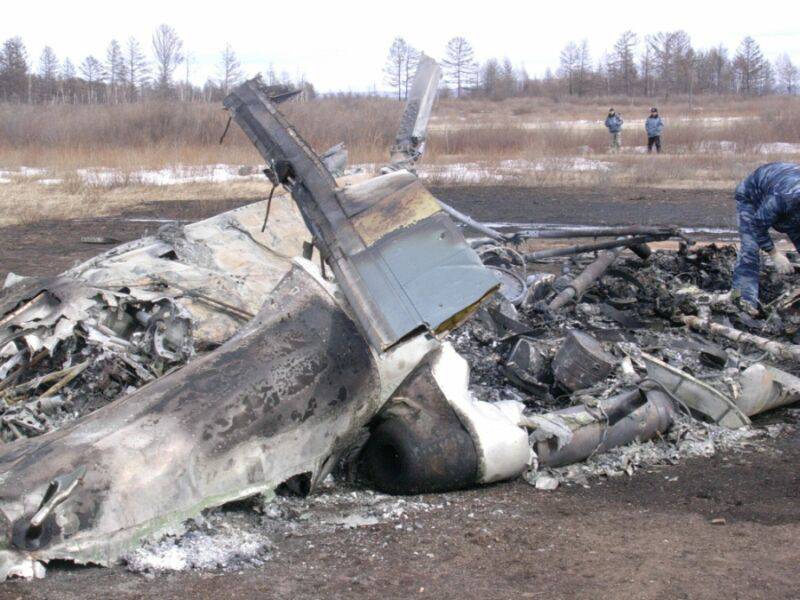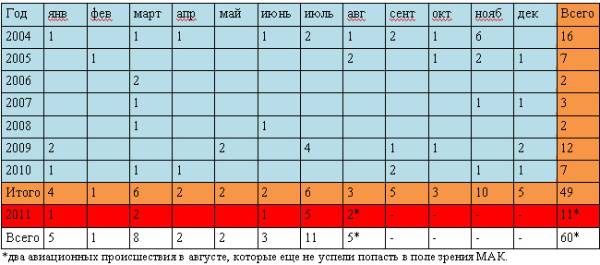Emergency helicopters in 2011g. may be a record

We "forgot how" to call aviation events in their own names. Journalists and correspondents were so intimidated, they say, they “escalate” the situation around the high accident rate of helicopters that any accident in the media automatically turns into a hard landing (even if the crew left the aircraft). Observers, like a spell, repeat: they die more in automobile transport than in air transport (but the “gross” criterion does not fit here - cars of passengers and goods carry more than aviation). And the operators (helicopter operators) would generally be forbidden to talk about incidents. Probably, in the hope that everything will be forgotten and the next accident or disaster will eclipse previous events.
The current situation with the accident rate of helicopters requires a serious discussion, because 2011 year threatens to become the most emergency in the last decade. Take a look at the accident and crash of helicopters "from the list of investigations" IAC.

In general, the nature of the distribution of incidents remains unchanged. The accident rate lives by its own internal laws: two “black” quarters fall-winter (November, December, January) - 38,4% of incidents, summer-autumn (July, August, September) - 28,5% and falling out March - 12,2%. However, only in the first seven months of this year, the accident rate has already exceeded the previous figures, and August did not bring any easing. Add to this the incidents with the helicopters of the Ministry of Defense and ROSTO and it becomes clear that if no effective measures are taken, the year may well be the worst in the last 10 years.
What is being done to ensure helicopter flight safety? The supervisory authorities regularly report on the work done: “119 AF was inspected, 220 comments were found from them 24 - affecting flight safety”, fines were imposed ... So what? About fines. It takes time, nerves, effort and money, and the size of the fine does not exceed a thousandth of a percent of the minimum possible damage ?! Regarding the role of supervision. Supervision is not the number of checks and observations, or even a slice of the technical condition of the aircraft, but the management of the state of the system as a whole. And you need to manage the processes. A good example is the investigation of the recent crash of the Ka-32С helicopter revealed a whole bunch of flaws that directly affect the PSU, which are based on not random, but long-term violations.
“The cause of the crash of the RA-31584 helicopter (based on the Investigation Report) was the engine shutdown due to the rotation of the main rotor. The reason for the spinup is the destruction of the outer horizontal roller (IGW) of the drive for the speed control of the free turbine. The most likely cause of destruction of HBV is poor-quality implementation of the seal at the factory "(" Motor Sich "). But such destruction is already more than three decades old! Further more. “When repairing the engine, the obligatory replacement of the roller was not performed and the twisting angle was not measured. The operation did not carry out work on the inspection of HBV, the specialists are not fully prepared to monitor the technical condition of the roller "...
The circle is closed: the designers did not eliminate the design-production flaw; in the repair did not replace; in operation did not look, because are not prepared. What kind of courtesy can we talk about if at any stage of the life cycle (production, repair, operation) a future catastrophe was not prevented.
The role of supervision is to manage (influence, influence) security changes. It is too late to influence on the platform. A qualitative change in the state of helicopters occurs in repair, during modernization, when resources are renewed, units are replaced, hence the management of repair, extension, investigation processes ... Investigations of one in which the essence is not “hidden” behind clever arguments about a combination of factors. Or gusts of wind, as a factor in the accident rate. We are going to explore the Arctic, board ships and offshore platforms, and there are often gusts of wind. With such an attitude to safety, the road to the pole will be littered with helicopters ...
The main cause of accidents and disasters of our helicopters consists of two components. The first - the design of the Soviet helicopters requires highly qualified flight and engineering staff. The second - to the great regret, the reserves of highly qualified flight and engineering staff ended. To change the situation, first things should be called with their own names: accident - accident, catastrophe - catastrophe, "counterfeit" - "counterfeit", nonprofessional - nonprofessional ...
Information